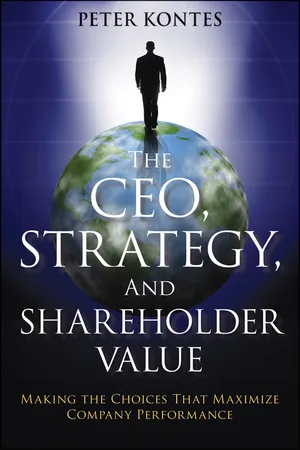Evaluating Business Success Based on Objectives
Evaluating business success based on objectives involves assessing the extent to which a company has achieved its predetermined goals and targets. This process typically involves measuring key performance indicators and comparing them against the established objectives to determine the level of success. By aligning evaluation with objectives, businesses can gain valuable insights into their performance and make informed decisions for future strategies.
7 Key excerpts on "Evaluating Business Success Based on Objectives"
- eBook - ePub
Business
The Ultimate Resource
- Bloomsbury Publishing(Author)
- 2011(Publication Date)
...Setting Objectives for a Business by Allan A. Kennedy EXECUTIVE SUMMARY • Managing inherently involves setting a goal or objective and then executing a series of actions to meet it. Establishing the right objective is critical to successful management of any business. • Successful long-term businesses almost always started with a set of nonfinancial objectives (sometimes referred to as a vision or mission) and derived financial objectives consistent with pursuit of their broader goals. • Setting only financial objectives is risky for a business because single-minded pursuit of financial objectives can lead to actions that undermine long-term viability. INTRODUCTION Managing is the task of moving an enterprise toward a defined objective. Most of the disciplines of management—budgeting, strategic planning, performance monitoring—take as a given that an appropriate objective has been set. Given the central role that objectives or targets play in most management actions, it is critical that they be set correctly. It may seem trite to point out, but it is none the less valid: if inappropriate objectives are set for a business, inappropriate outcomes will occur. What constitutes appropriate objectives for a business? As business and management have evolved, thinking about what constitutes an appropriate objective has evolved as well. Throughout this evolution, there has been an ongoing tension between financial goals and objectives and nonfinancial objectives. If business exists primarily or solely to make a profit (a highly quantifiable outcome) then relatively simple financial objectives suffice, argue some. Others say that business exists to serve simultaneously the needs of various constituencies—stockholders, customers, suppliers, employees, communities. The interests of these various legitimate constituencies are not always quantifiable, leading to a school of thought that puts greater emphasis on nonfinancial objectives...
- eBook - ePub
- Barry Witcher(Author)
- 2019(Publication Date)
- Routledge(Publisher)
...5 Objectives Essential summary Objectives are strategically desired outcomes that must be managed effectively if the organization is to continue to fulfil its purpose. The balanced scorecard is a documented set of objectives and measures grouped typically into four perspectives. Critical success factors (CSFs) are the factors that primarily account for an organization’s success in achieving its strategic purpose. Key performance indicators (KPIs) are targets used to monitor progress on strategy-related incremental objectives. Strategy maps are pictorial representations of the relative order of balanced scorecard perspectives, which are used to illustrate cause and effect. Strengths, weaknesses, opportunities, threats (SWOT) is a mnemonic framework used to strategically analyze an organization’s strengths, weaknesses (concerned with internal factors), opportunities, and threats (arising because of changes in external factors). An objective is a statement of a specific outcome that is to be achieved. Objectives must be meaningful and clear to the people who use them and linked to realistic measures of progress so that those managing the objectives will know in enough time if it necessary to intervene and make appropriate changes. Objectives are the basis of a common language for understanding the context of work and identifying the inevitable knock-on effects of change. Of course, this requires common ways of working that are based on dialogue and consensus to facilitate the development and management of objectives in ways that are transparent and can be understood by all. This makes work easier. To establish clarity in objectives, conventional objectives should be SMART: Specific Measurable Action-oriented (and agreed upon) Realistic Time-bound Strategic objectives can be open, general, and intangible; they can also be long term and ambitious – perhaps to an extent that seems unrealistic...
- eBook - ePub
The CEO, Strategy, and Shareholder Value
Making the Choices That Maximize Company Performance
- Peter Kontes(Author)
- 2010(Publication Date)
- Wiley(Publisher)
...CHAPTER THREE Choosing the Right Performance Objectives THE STARTING POINT OF good strategic management is choosing the right performance objectives for each business unit and for the company overall. The entire future of the enterprise will be affected by how well or badly these objectives are chosen. If, for example, a company chooses to give priority to increasing earnings growth, then its strategies will evolve very differently than they would if it chooses instead to emphasize increasing return on investment. Over time, this divergence of strategies could result in two completely different companies, with different business unit portfolios, different competitive positioning, different share price performance, and different risk-taking behaviors. Recognizing this problem, but not having a good solution, many companies try to finesse the choices by seeking a “balance” between growth and returns, or between the short term and the long term, or between cash generating and cash consuming business units. But “balancing” tends to produce a profusion of competing objectives which, more often than not, means having no meaningful objectives at all. For example, almost all strategic decisions involve trade-offs: raise prices (but reduce growth), add product features (but raise costs), start a new marketing campaign (but, again, raise costs), expand into a new market (but increase investment and reduce return on investment). The fundamental question of how to strike the proper “balance” among these commonly encountered trade-offs is usually left unanswered. The choice of performance objectives is so fundamental to the success of the company that it falls naturally to the CEO. In making that choice, the CEO should establish business unit and company performance objectives that are consistent with, and supportive of, committing the company’s resources to the strategies that maximize the growth of economic profits over time...
- eBook - ePub
Armstrong's Handbook of Performance Management
An Evidence-Based Guide to Performance Leadership
- Michael Armstrong(Author)
- 2022(Publication Date)
- Kogan Page(Publisher)
...11 Defining objectives Introduction Objectives indicate what has to be accomplished. Their definition is a fundamental activity in managing performance. They provide direction and a basis for monitoring performance, and they help to communicate the organization’s strategic goals to employees. This chapter starts with a definition of the meaning of the term ‘objectives’ and continues with a review of the conceptual background and a description of the processes of defining objectives and strategic alignment. The meaning of objectives The terms ‘objectives’ and ‘goals’ are often used interchangeably, both meaning an outcome to be achieved. But it is possible to distinguish between them. Goals are expressions of overall ambitions and intentions. They set out what, in general, an organization or an individual wants or needs to do in the longer term. Objectives are specific aims or targets, the achievement of which will support the attainment of these goals. Thus the strategic goals for a business could be to increase market share, to improve productivity and to minimize harmful impact on the environment. In each of those areas objectives could be set in the form of quantified targets or a definition of some other form of measurable achievement. Individuals have overall goals, for example, to improve performance, behave in accordance with accepted standards, develop skills or further their careers. They also have objectives in the form of the precise actions and measurable steps required to achieve overarching goals – those of the organization (the process of strategic alignment) as well as their own. There are two types of objectives: performance and personal. Performance objectives Performance objectives are generally expressed by simply defining each of the main activities the role involves in terms that indicate the expected outcomes or the purpose of the activity...
- eBook - ePub
Strategic Sport Communication
Traditional and Transmedia Strategies for a Global Sports Market
- W. Timothy Coombs, Jennifer L. Harker(Authors)
- 2021(Publication Date)
- Routledge(Publisher)
...Evaluation helps you to understand the strengths and weaknesses in your scanning, research, planning, and communication stages. For instance, your evaluation might prove the value of a particular social media platform or uncover problems with understanding and moving a particular target segment. Think of evaluation as the step that unites all the other steps. Your scanning and research created the information necessary for you to plan (objectives are essential to evaluation), to create, and to disseminate your messages. But was the opportunity really beneficial and did you have the proper information? You answer the broader question of “Did you effectively leverage an opportunity or mitigate a threat?” Evaluation helps you to understand what you did well and not so well during the entire strategic communication effort. While we visualize the strategic communication as a process with one step following another, we need to remember that every step in the strategic communication process is related in some way to every other step in the process. Evaluation allows you to take stock of your actions during the complete strategic communication process. This chapter is a review because it draws upon the other four stages in the strategic communication process. The central focus of evaluation involves objectives and the need to consider larger organizational goals in evaluation. Evaluation and Objectives Without proper objectives, you cannot execute evaluation. Objectives provide your standard of success by specifying what should occur when the target segment is moved by your messages. Metrics are an essential element of evaluation. A metric is a quantifiable measure used to track and to assess the status of a process. A variety of metrics are used when assessing objectives. In this section we revisit the types of objectives and types of change to understand how each relate to evaluation...
- eBook - ePub
The Executive's Guide to Corporate Events and Business Entertaining
How to Choose and Use Corporate Functions to Increase Brand Awareness, Develop New Business, Nurture Customer Loyalty and Drive Growth
- Judy Allen(Author)
- 2009(Publication Date)
- Wiley(Publisher)
...CHAPTER TWO HOW TO QUALIFY YOUR COMPANY OBJECTIVES FOR A PROPOSED BUSINESS FUNCTION TO SUCCESSFULLY DESIGN the right business function to deliver the results you are looking for, it is important to examine and set all possible company objectives at the outset and prioritize them. Knowing your key objectives will help you choose the right vehicles to meet them. Avoid the desire to designate the type of event that you want to hold before you begin to consider your business objectives. Several types of business functions may meet some of the same objectives. For example, a product launch and sponsoring a gala fundraising that will showcase your new product could both conceivably bring about media exposure and brand awareness, but would provide different levels of return in each area. It is important to decide which business function will meet more of your primary requirements so that you can then move forward to determining the role that will best serve the company...
- Robert E Stevens, David L Loudon, R Henry Migliore, Stanley G Williamson(Authors)
- 2013(Publication Date)
- Routledge(Publisher)
...They are not commands, but they are commitments. They do not determine the future, but they are the means by which the resources and energies of the operation can be mobilized for the making of the future.” 2 Objectives can be defined as clear, concise written statements outlining what is to be accomplished in key areas in a certain time period, in objectively measurable terms. Objectives can be classified as routine, problem solving, innovative, team, personal, and budget performance. Objectives can be set at upper organizational levels in key result areas such as growth, finances, physical resources, staff development and attitudes. They are also needed in sub-units, departments, or divisions of an organization. Most important, all organizational objectives must be consistent. Thus, a department’s objectives should lead to accomplishing the overall organization’s goals. Objectives serve two fundamental purposes. First, they serve as a road map. Objectives are the results desired upon completion of the planning period. In the absence of objectives, no sense of direction can be attained in decision making. In planning, objectives answer one of the basic questions posed in the planning process: Where do we want to go? These objectives become the focal point for strategy decisions. Another basic purpose served by objectives is in the evaluation of performance. The objectives in the strategic plan become the yardsticks used to evaluate performance. As will be pointed out later, it is impossible to evaluate performance without some standard by which results can be compared. The objectives become the standards for evaluating performance because they are the statement of results desired by the planner. Objectives have sometimes been called the neglected area of management. In many situations there is a failure to set objectives, or the objectives which are set forth are unsound and therefore lose much of their effectiveness...






